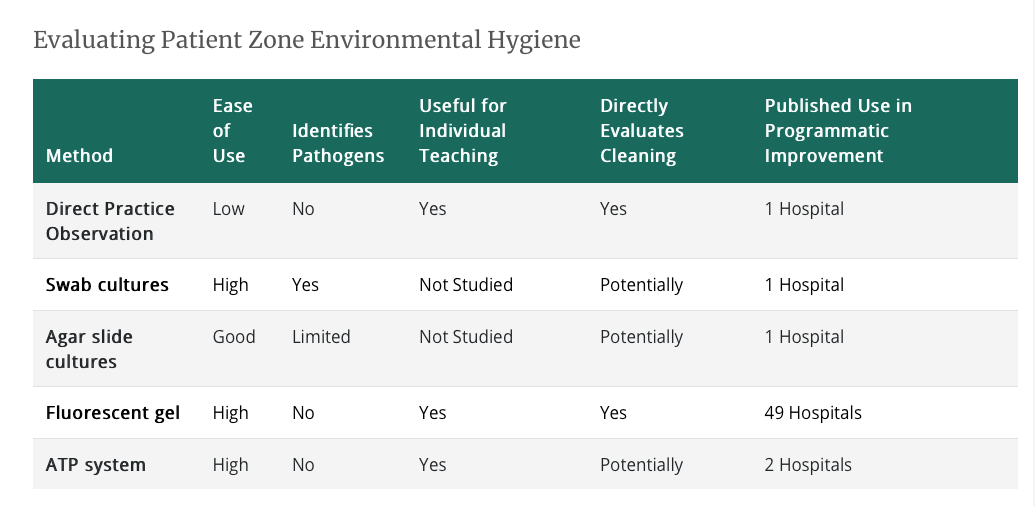Not Blinded by the Light: Assessing ATP’s Disinfection Potential
Adenosine triphosphate (ATP) bioluminescence needs technological enhancement if it’s to reach its full potential as a disinfection tool, says a study.
There seems to be an opportunity for inventors and entrepreneurs when it comes to disinfecting surfaces on high-touch environmental surfaces (HITES) in health care facilities and other settings. Adenosine triphosphate (ATP) bioluminescence is a signal that can potentially identify bacterial and fungal surface contamination on HITES. However, there are major drawbacks to the technology, according to a meta-analysis in the web publication InfectionControl.tips.
“Despite over 50 years of research on ATP bioluminescence, there continue to be many unanswered questions with respect to improving its use in monitoring the microbial quality of environmental surfaces,” the study states. “The most prevalent issue is the lack of consensus on what an actual ATP signal signifies and perhaps more importantly, what an absence of signal represents.”
Source: Centers for Disease Control and Prevention

The study was cowritten by Syed A. Sattar, PhD, and Jason A. Tetro, BSc. Sattar is the cofounder and chief scientific officer at a company called CREM, which bills itself as a research and development institution that focuses on infection control and prevention. Tetro—the author of 2 highly acclaimed books, The Germ Code, and The Germ Files—has been interviewed many times by Infection Control Today® throughout the course of the COVID-19 pandemic, most recently here, where he predicted that the Delta variant will soon burn itself out like a wildfire. But also here, here, and here, to note just a few more of the Q&As ICT® has conducted with Tetro.
The study in InfectionControl.tips lists some of the positives about ATP that encourage many health care systems and other industries to utilize it in disinfecting and sterilization processes. For one thing, it’s relatively cheap. In addition, the ATP tests have demonstrated good reproducibility. In a laboratory. Take the test outside of the lab, though, and problems can arise, according to the study. The test can’t measure microbial loads with relative light units (RULs). And while it seems to be able to detect bacterial and fungal contamination, it can’t spot non-ATP-producing species, such as viruses and spores. In addition, the presence of disinfectant residue can interfere with the ATP test.
“As a result, the test cannot be used in a quantitative manner,” the study states. “Instead, it may serve a qualitative purpose for the auditing of cleaning techniques and possibly to identify areas that may be missed during a cleaning regimen.”
The study suggests some methods that might be able to make the ATP tests more reliable. For instance, benchmarks can be included in the tests to better interpret results. In addition, health care facilities and other businesses that use the test could approve a list of chemicals that would not interfere with the ATP’s bioluminescent signal.
As it is, though, the study maintains that there are only a few environments in which the test—though cost-effective—might be worth it. They include pharmaceutical companies and electronics manufacturers, institutions that are always on the lookout for any contamination.
“More dynamic facilities, such as those in health care, education, and the food continuum may not be appropriate for this type of test,” the study states. “In essence, the overall value of the ATP test can be best summarized in the level of chemical complexity. In those that are simple, the test is appropriate. But in areas where the chemical complexity is high, it may be best to look at another option.”
For these and other reasons, the ATP technology needs to be enhanced perhaps through the invention of a hybrid test that bathes surfaces in a “solution containing nanoparticles that possess antibodies against viral and spore proteins,” the study states. “Upon interaction, the particles release ATP and this can be measured in addition to the ATP from the bacterial load. Of course, this technology has yet to be developed and will require significant resources to develop.”
“Ongoing Assault”: How HHS Layoffs Have Eviscerated Infection Prevention Support Across the Nation
April 1st 2025Mass layoffs at HHS and CDC have gutted critical infection prevention programs, leaving frontline professionals overwhelmed, under-resourced, and desperate to safeguard public health.
Together We Rise: Why AORN Expo 2025 Is a Must for Every Perioperative Nurse
March 31st 2025From April 5 to 8, 2025, thousands of perioperative nurses will gather in Boston for the 2025 AORN Global Surgical Conference & Expo—a transformational experience designed to elevate nursing practice, build lifelong connections, and advance surgical care.
Vet IP Roundtable 2: Infection Control and Biosecurity Challenges in Veterinary Care
March 31st 2025Veterinary IPs highlight critical gaps in cleaning protocols, training, and biosecurity, stressing the urgent need for standardized, animal-specific infection prevention practices across diverse care settings.